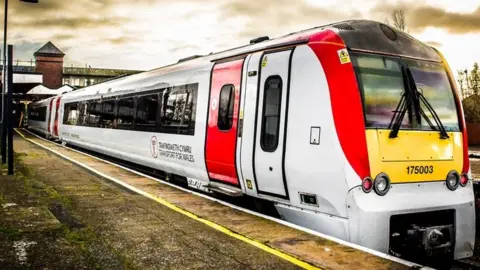Railway passenger growth reaches 11-year high
 TfW
TfWThe number of passengers using railway stations in Wales has grown by the largest amount in more than a decade.
More than 57.4m people used stations in Wales in 2018-19, up 9.4% from 52.5m the previous year, the largest rise since 2007-08.
Much of the growth occurred in the area surrounding Cardiff, with valleys and suburban stations seeing large rises.
Swansea, Bangor and Rhyl stations were among the 20 busiest, but increases were modest compared to the south east.
The figures, released by the Welsh Government, measure the number of entries and exits to railway stations over a 12-month period between April 2018 and March 2019.

Cardiff Central was the busiest station in the country, with 14,204,684 entries and exits, a rise of more than 1.2 million compared with the previous year.
But the greatest rise in passengers was on lines around the capital.
Of the 10 stations that saw the largest growth, seven were within Cardiff county, and the other three were on lines travelling into the capital.
Away from the capital region, changes have not been so marked.
Swansea station, the fourth busiest in the country, saw growth of 2.1%, up to 2.2 million last year.
Elsewhere in the south west, Llanelli station saw numbers drop by 0.2% and Carmarthen by 7.8%.
In mid Wales, overall passengers on the Cambrian main line dropped by 4.6%, with the number going through Aberystwyth station falling by 7.6% to 309,816.
In the north of the country, Bangor and Rhyl were among the 20 busiest, ranking 15th and 19th respectively, but growth was just 0.8% in Bangor and numbers fell by a handful of passengers in Rhyl.
Numbers increased modestly elsewhere, by 2.2% on the North Wales Coast Line, 2.6% on the Conwy Valley Line, and 3.8% on the Borderlands Line.

Steve Fletcher, a commuter and the founder of the Arriva Trains Failed Wales Facebook page, said: "It surprises me that so many people are using rail, knowing how bad it is. It probably reflects even worse on all other forms of transport.
"The rail is getting no better. It went through an appalling service level in December and January time. I have put in no end of claims. It really surprises me that people continue to use it.
"It's very difficult to tell when you're used to being face-to-face with people every day. It's just different levels of discomfort.
"You notice more people left behind in the station now who are just unable to get on to the train in the mornings.
"It's the lesser of all the evils. It's the least worst rather than the best."
Transport for Wales (TfW) said it was "encouraged" to see more people using the rail network and was embarking on an £800m investment programme.
"More trains will be arriving later in the year, which will allow us to withdraw our oldest trains which will mean more seats on our trains," a spokesperson added.
"We also have exciting plans to build the South Wales Metro plus more reliable and more frequent trains.
"In December, we introduced an additional 186 Sunday services and by December 2023, we are going to run an extra 285 services every weekday."
However figures suggest some new trains on the Rhymney line's Bargoed and Penarth routes will have less capacity.